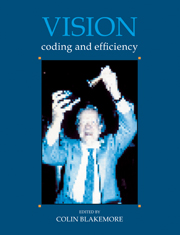Book contents
- Frontmatter
- Contents
- List of Contributors
- Preface
- Reply
- Acknowledgements
- Concepts of coding and efficiency
- Efficiency of the visual pathway
- Colour
- 11 The two subsystems of colour vision and their rôles in wavelength discrimination
- 12 The effect of the angle of retinal incidence on the color of monochromatic light
- 13 Fourier Interferometric Stimulation (FIS): the method and its applications
- 14 The chromatic coding of space
- Brightness, adaptation and contrast
- Development of vision
- Depth and texture
- Motion
- From image to object
- Index
14 - The chromatic coding of space
Published online by Cambridge University Press: 05 May 2010
- Frontmatter
- Contents
- List of Contributors
- Preface
- Reply
- Acknowledgements
- Concepts of coding and efficiency
- Efficiency of the visual pathway
- Colour
- 11 The two subsystems of colour vision and their rôles in wavelength discrimination
- 12 The effect of the angle of retinal incidence on the color of monochromatic light
- 13 Fourier Interferometric Stimulation (FIS): the method and its applications
- 14 The chromatic coding of space
- Brightness, adaptation and contrast
- Development of vision
- Depth and texture
- Motion
- From image to object
- Index
Summary
Introduction
Colour vision is a means of encoding the spectral reflectance of a surface. Thus the contours, edges or patterns which allow us to distinguish an object against its background may be seen both by virtue of their intensity variation and on the basis of their colour variation. Over the past three decades a relatively new approach to the investigation of colour vision has been emerging. This involves creating a stimulus from which the variations in intensity have been removed and so allowing it to be distinguished solely on the basis of its colour differences. Such stimuli are often termed ‘isoluminant’. In this chapter I aim to examine some of the difficulties associated with the use of colour-only stimuli and to assess their contribution to the understanding of the spatial coding of colour vision.
The problems of colour-only stimuli
Chromatic aberrations
There are considerable optical difficulties inherent in the use of chromatic stimuli, which have to be overcome in order to remove all luminance artifacts and ensure that the stimulus can be detected only on the basis of its colour variation. These arise largely from the two types of chromatic aberration of the eye. The chromatic difference of focus, the increasing power of the eye for shorter wavelengths of light, affects the relative contrasts of the sinusoidal component colours in a chromatic grating. (A chromatic grating can be considered as the sum of two luminance modulated gratings added in antiphase.) This is often corrected by using an achromatizing lens, a small pupil or by correcting the relative amplitudes of the component wavelengths. The second aberration is the chromatic difference of magnification.
Information
- Type
- Chapter
- Information
- VisionCoding and Efficiency, pp. 150 - 158Publisher: Cambridge University PressPrint publication year: 1991
Accessibility standard: Unknown
Why this information is here
This section outlines the accessibility features of this content - including support for screen readers, full keyboard navigation and high-contrast display options. This may not be relevant for you.Accessibility Information
- 1
- Cited by
